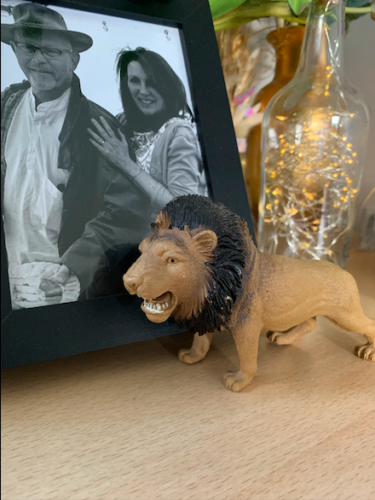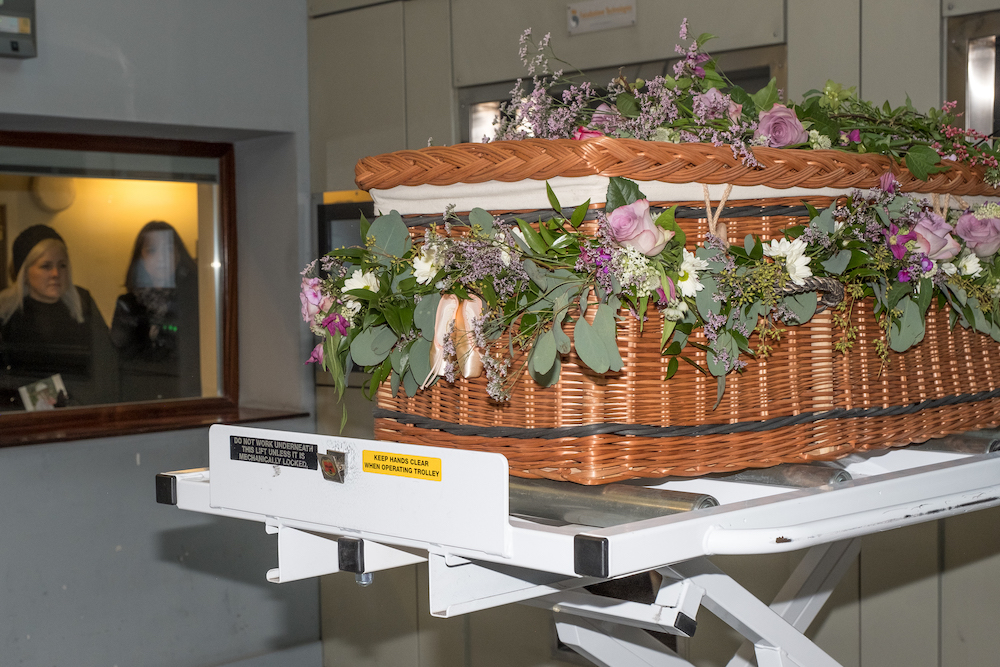
With well over 3/4 of British funerals now culminating in cremation, and with the relentless promotion of direct cremation on mainstream TV channels, we thought it was about time to look at the cost of being cremated in 2022.
The Competition and Markets Authority’s Funeral Market Investigation Order 2021 mandated that all crematoria must publish their prices, which has made this research possible (even if not easy!) – we are extremely grateful for this new transparency.
Some important provisos before we start – for the purpose of this blog post, and to avoid completely drowning in numbers, we are only focusing on the cremation fees here, not the full price for a funeral. Once funeral director fees are added on, the total costs will, of course, be significantly higher.
We have looked at the price charged for a standard adult cremation, with a ceremony at 11.00am or thereabouts, where varying prices are shown for different times of the day.
We aren’t comparing the multiple different prices for direct cremations, or ‘attended direct cremations’, we’re simply looking at the standard cremation fees published by the crematoria companies.
There are lots of numbers and links, but we’ll try to make it easy to follow – we’ll break it up with some gorgeous photos by Rachel Wallace taken at the wonderful Mortlake Crematorium, run by a collective of four London Boroughs (and where cremation fees are among the lowest 10% in the country!)
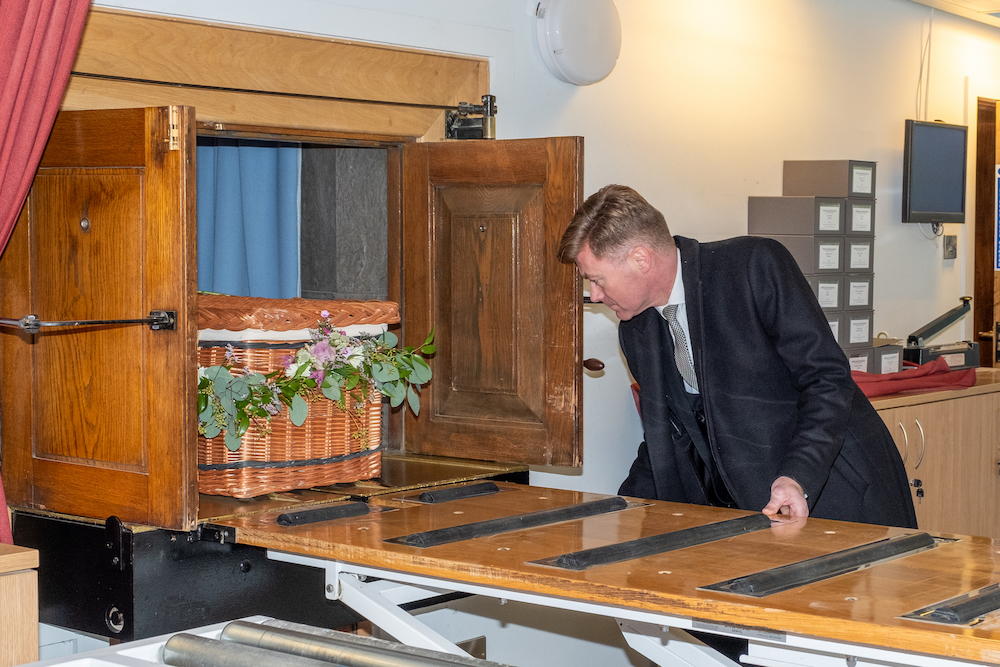
The first and most obvious finding is that there is an absolutely enormous disparity across the country. You could almost describe it as a postcode lottery.
The tremendously useful league table from The Cremation Society of Great Britain (CMS) shows an astonishing range of fees; the 2021 fee for a single standard adult cremation ranged from £392 to £1,100, a difference of £708.
Citizens of Belfast have access to the lowest cremation fees in the United Kingdom, with the local authority run City of Belfast Crematorium currently charging residents of the city a very reasonable £408. But back across the Irish Sea, for those of us in the rest of the UK, things are very different.
The CMS league table tells us that there were 312 crematoria operating in 2021, and of these, (excluding Belfast), 90% of them charged more than £700, while the latest cremation statistics from the same source show that the average total cremation charge in the UK in January 2022 was £867.75.
The crematorium with the highest standard fee is the independently owned Parkgrove Crematorium in Angus, Scotland, where the fee for an adult cremation is £1,100.
Head south to Oxfordshire and a ceremony at a ‘premium time’ (12.00, 13.00 or 14.00) will cost you even more – £1,140 for a lunch time ceremony at either of the two Memoria run crematoria – North Oxfordshire Crematorium and South Oxfordshire Crematorium.
Now, it’s an interesting thing that there are three crematoria serving Oxford and the surrounding area – all privately owned, the above two owned by Memoria, and a third, Oxford Crematorium, owned and run by Dignity PLC (now rebranded as The Crematorium and Memorial Group). A 60 minute ‘slot’ at any of these three crematoria will cost a minimum of £1,070 (at the Dignity crematorium), while the two Memoria crematoria both charge £1,090 for an 11am booking.
Down in the seaside town of Brighton, however, there are two crematoria, one local authority run, the other privately owned. Woodvale Crematorium is run by Brighton & Hove City Council, and charges £715 for a cremation, while half a mile away, Dignity operate The Downs Crematorium and somehow manages to undercut the local authority with a cremation fee of £678. A whopping discount of £392 compared with the Dignity price of £1,070 for a cremation in Oxford – or at nine of their other crematoria across the country.
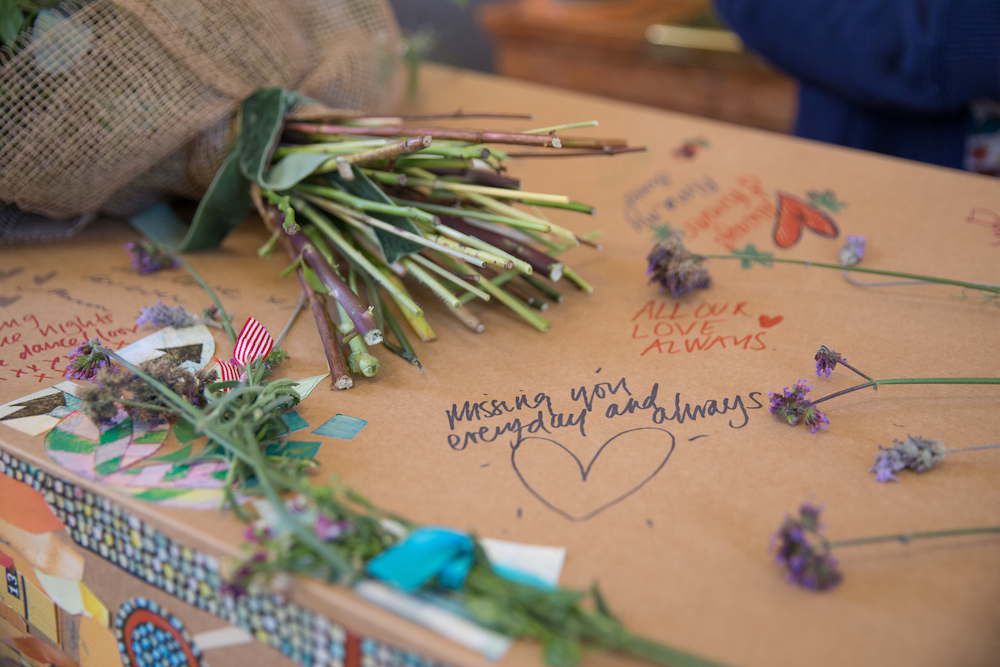
Prices at the remaining Dignity crematoria (there are 46 in total) range between £675 at Stockport Crematorium (that’s a one-off, the lowest price charged by any crematorium in the group, and perhaps reflective of the fact that there are 13 other crematoria serving the Greater Manchester area) to £1,060, which curiously is the fee charged by both of the Dignity owned crematoria which serve the people of Norwich, Earlham Crematorium and St. Faiths Crematorium.
No other crematoria are located in the city, so to find a lower cost cremation fee in the Norwich area you’d need to travel half an hour west to the privately owned Breckland Crematorium (£895), head 23 miles north to Cromer Crematorium, operated by the Westerleigh Group (£1,040), take a 50 mile round trip to the local authority run Great Yarmouth Crematorium (£895) or drive a similar distance to the Memoria crematorium Waveney Memorial Park (£945).
Dignity aren’t the only company that appear to be sensitive to the pricing of nearby crematoria – over in Retford, in Nottinghamshire, a 11.00am cremation at Memoria’s Barnby Moor Crematorium is priced at £775,while the Westerleigh owned Babworth Crematorium, two and a half miles away, charges £825.
These are among the lowest prices charged by either operator; all of Memoria’s other crematoria charge between £930 – £1,090, while Westerleigh has one crematorium charging less (Aylesbury Vale Crematorium at £699) and 35 other crematoria charging between £850 – £1,115. (The Westerleigh crematorium at Aylesbury Vale is just three miles from Bierton Crematorium which is operated by three local councils and charges a cremation fee of £700.)
It is clear that a large part of the cremation fee charged by crematoria is the hire fee for the ceremony space, as there are significantly discounted fees for early morning and unattended cremations – most crematoria charge between £350 – £500 for a direct cremation, but as the majority of people still choose to hold a ceremony, the disparity across the country in prices of the cremation fees that families are required to pay is shocking.
Setting aside the coincidence of (extraordinarily) similar fees to close competitors or sister crematoria in some locations, the range of prices charged by the same operators in different areas and the very significant difference between the lowest and highest fees around the country, the situation of crematorium fees is more concerning in the light of initiatives from two of the cremation companies:
Pure Cremation Ltd (they of the cutesy daytime TV adverts) operate Charlton Park Crematorium, which is where the cremations arranged under their nationwide direct cremation service are carried out.
The crematorium can also be used by families not employing Pure Cremation, and prices range from £450 for a direct cremation to £900 for an hour in the ceremony room.

So far, so par for the course. Until you see the advertisements placed by Pure Cremation in the trade magazines for the funeral sector.
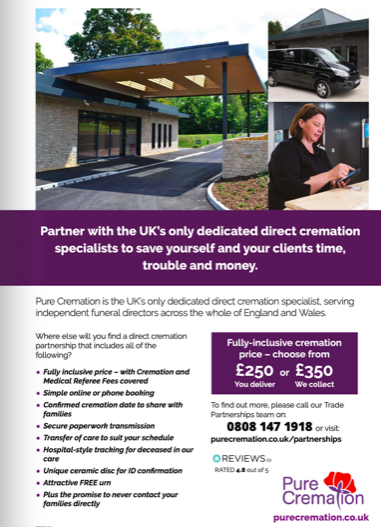
What the company is offering to funeral directors that partner with them is a preferential cremation fee – £250 where the funeral director delivers the coffin to Charlswood Park, and collects the cremated remains by appointment, £350 where the Pure Cremation team collect the coffin from the funeral home and return the cremated remains by hand.
The copy on their website page for partners states ‘Some people only want the simplest direct cremation at the lowest possible cost but would prefer to be looked after by a local firm. Our low cremation fees mean that you can say “Yes” to serving these families at a price that they feel good about… yet still achieves a healthy margin for you.’
This sounds excellent from a client’s point of view; a local funeral director service, an efficient direct cremation and the cremated remains returned to them. All at the lowest possible price (assuming that the saving on the cremation fee is passed on by the funeral company concerned, of course).
It also makes it clear that the actual cost of cremating an adult is less than £250.
Otherwise, Pure Cremations wouldn’t be offering this service at this price.
Memoria appear to have been similarly struck by inspiration at the idea of partnering with funeral directors, although they have a slightly different take on it. They are also offering discounted cremation fees to select funeral directors – £300 in this case for direct cremations, £400 for small, attended funeral ceremonies before 11.00am.
A letter from former owner and current Group CEO, Howard Hodgson, landed on the doormats of funeral directors recently, notifying them of an upcoming Memoria TV advertising campaign promoting ‘affordable, local and attended cremation funeral services as an alternative to direct cremation’, and inviting them to become a Memoria Brand Partner.
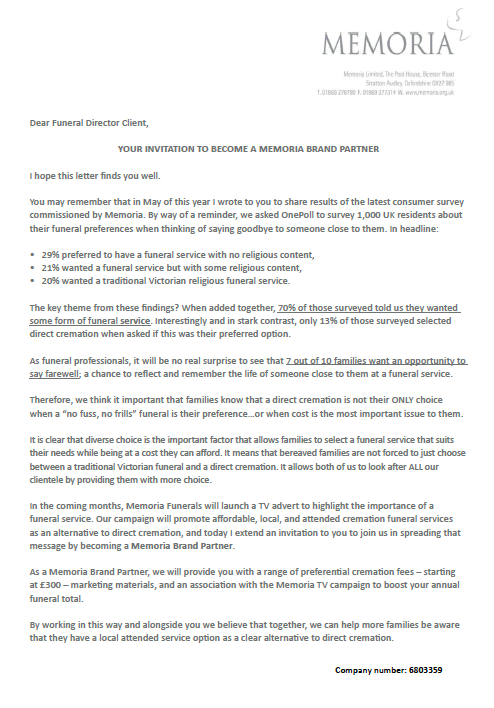
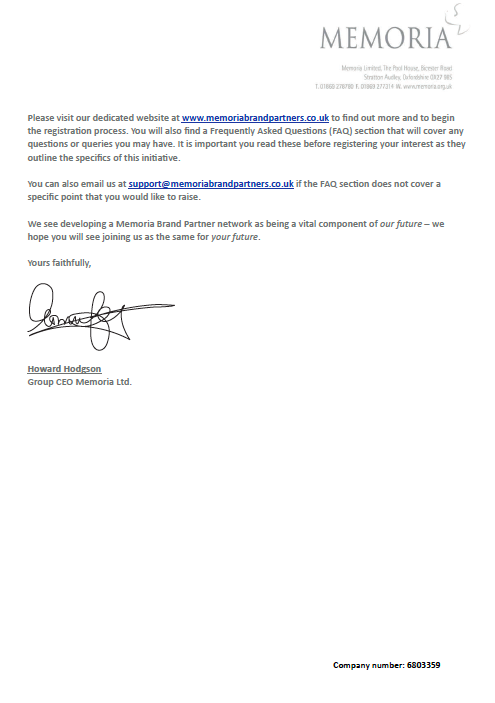
According to the FAQ’s on the website, a Memoria Brand Partner is ‘a funeral director who works exclusively with Memoria to offer the attended local funeral service – the Personal Funeral Service – to bereaved families as an alternative to Direct Cremation. Memoria is also to be their exclusive provider of their direct cremations.’
Brand Partners will benefit from ‘preferential cremation fees for both Direct Cremation (£300) and the Personal Funeral Service (£400)’ as well as branded marketing material and the backing of Memoria TV and digital advertising at no cost to their business.
Somewhat less appealing to most funeral directors, perhaps, is the fact that Memoria will, as part of the contractual arrangement required in exchange for the preferential cremation fees, set the total price of the Direct Cremation and Personal Funeral Service – £990 and £1,395 respectively.
It seems to us that this initiative by Memoria is not just an attempt to push back at the rise of direct cremation by promoting low cost, attended funerals, but it is also an attempt to enlist sufficient funeral directors to carry out the logistics of the ‘arranging’ elements of a funeral by enticing them to sign up as exclusive partners with discounted cremation fees. (Something similar was attempted by Memoria’s sister company, Low Cost Funerals, now rebranded as Affordable Funerals and listed at Companies House with the same directors as Memoria. Affordable Funerals already offer Direct Cremations and Personal Funeral Services at the same prices as those that we’ll see advertised by Memoria and their partners over the coming months).
The prices charged to non-affiliated funeral directors for direct cremations are listed as £450 at each of the Memoria crematoria, 50% higher than the £300 fee that Brand Partners will be charged for each cremation.
For small funeral directors, this is a significant amount to offset as part of their total package price. It could render it impossible for non-affiliated funeral directors to compete in price against companies who sign up as a Memoria Brand Partner – the former would have to provide all the services involved in organising a cremation for £540 after paying the £450 cremation fee, while the Brand Partner would have £690 left to cover the costs of overheads, staff, vehicles, coffin supply, insurance and so forth.
Effectively, Memoria’s initiative could make it impossible for small funeral businesses to offer direct cremations at a competitive rate in areas where there are no other crematoria available and where other funeral directors are partnering with Memoria and receiving discounted cremation fees. If this happens, then the ultimate loser will be the bereaved people whose choices will have been diminished.
So, what have we learned from this long (and possibly quite boring) deep dive into cremation fees? Mainly the following:
- That private companies are doing what they are supposed to do, i.e., making money.
- That an individual cremation can be carried out for under £250, with the company providing the service still making money from it.
- And that bereaved families are being charged an extraordinarily huge amount of money for the room hire for their funeral ceremonies. More than £800 an hour in some cases!
Armed with this knowledge, what can the public do?
We recommend – as always – asking a lot of questions before committing yourself to making funeral arrangements with any company. Think about what matters to you, make a list of things that you want to know, then call funeral directors and ask them.
If you are planning to have a funeral ceremony prior to cremation, you could explore the possibility of hiring a venue for the ceremony then arranging for the cremation to take place separately, perhaps early the following day at a reduced rate.
You may find that you can hire a village hall for the whole day for a ceremony and a reception for less than the cost of a 40-minute ceremony in a crematorium chapel. Or your local pub might be willing to let you book it for the day and have a ceremony in the garden. Maybe you or a relative have space to hold a ceremony at home? You do not need to be confined to holding a ceremony at a crematorium. Once you begin to think of alternative places and spaces, all kinds of possibilities may occur to you.
You could enquire about other crematoria rather than the one closest to you – do a Google search for ‘crematorium in *your area’. Look at the crematoria websites, they all list prices for both funeral services and for direct cremations, and many will show different fees for different times of the day. Often, local authority owned and run crematoria will charge less than the privately owned ones, although not always.
All funeral directors are required to list the fees of their local crematoria on their Standardised Price List which must be shown on their website, so you may be able to get an idea of costs in your area by checking these, but then double check with the crematorium itself in case fees have changed recently.
You may be considering a direct cremation? If so, be particularly wary of companies advertising themselves as direct cremation providers online.
We will be writing about this subject in detail in a dedicated blog post in the coming weeks, but for now we can summarise by recommending you always approach a company with a physical presence, a proper funeral director rather than an internet-based provider. Ask them exactly where the cremation will take place, and when. Ask for a breakdown of their advertised ‘direct cremation’ fee. Ask them if they and their staff will take the coffin to the crematorium, or if this part of their service is subcontracted. Ask them if any part of their service is subcontracted, and if so, to whom.
Remember, you are the client. You are paying for a service, and you have every right to know what you are paying for.
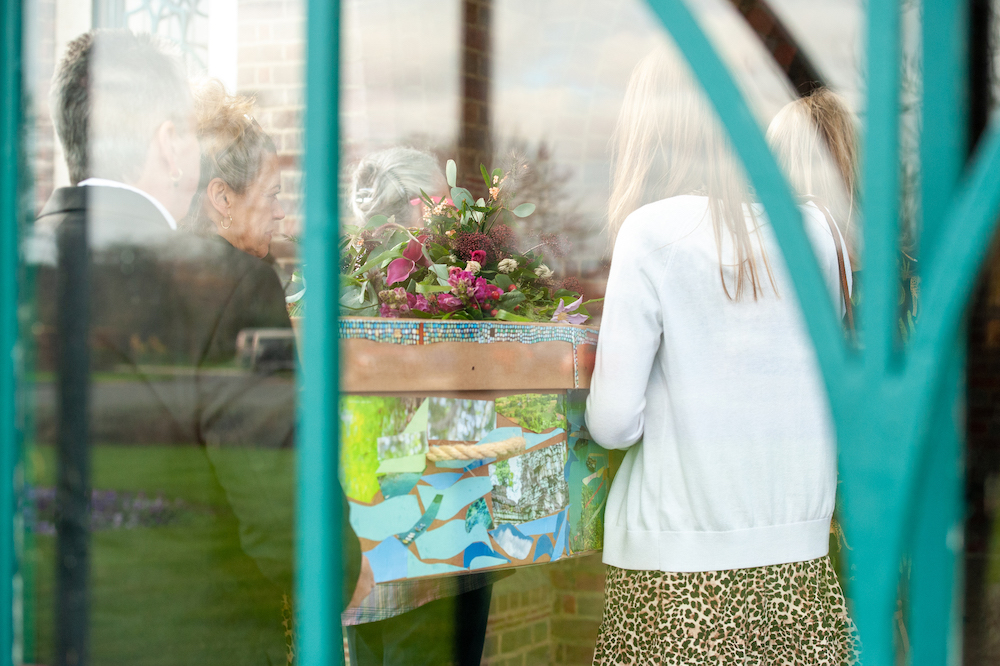

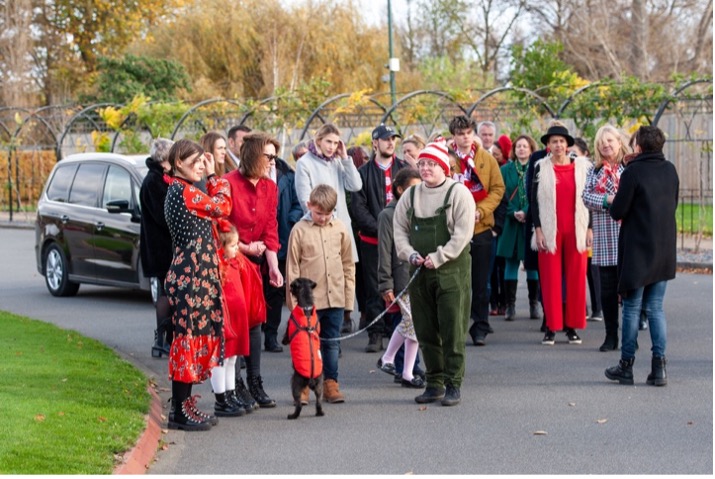
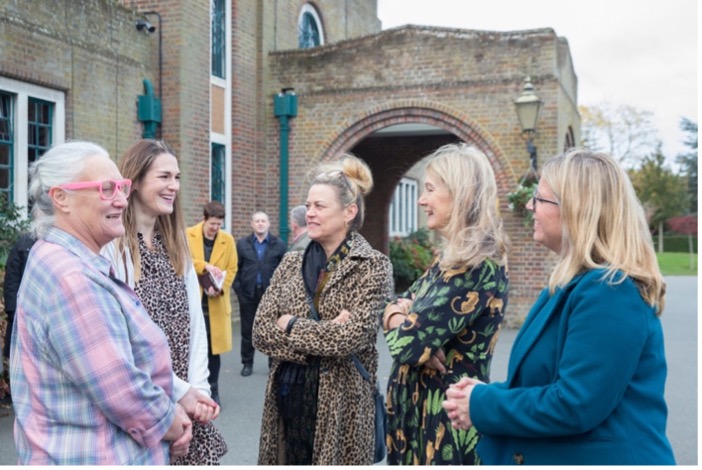



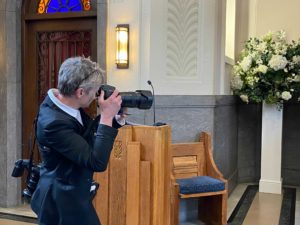
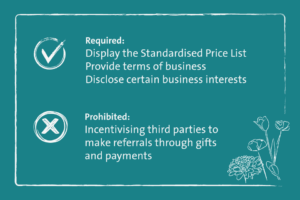
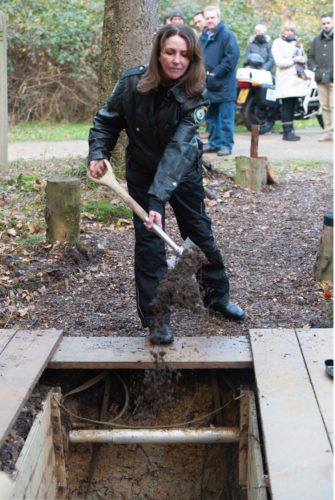 Photo credit: Rachel Wallace Photography
Photo credit: Rachel Wallace Photography